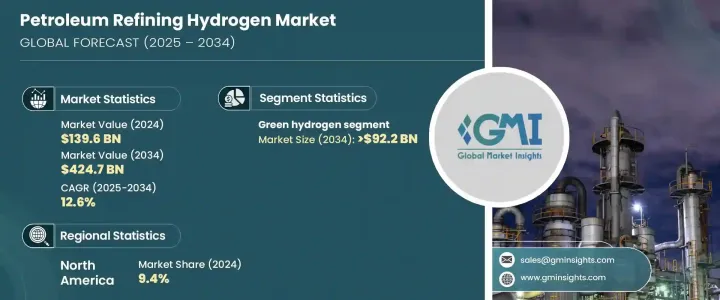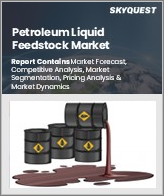
|
시장보고서
상품코드
1721433
석유 정제 수소 시장 : 시장 기회, 성장 촉진요인, 산업 동향 분석 및 예측(2025-2034년)Petroleum Refining Hydrogen Market Opportunity, Growth Drivers, Industry Trend Analysis, and Forecast 2025 - 2034 |
||||||
세계의 석유 정제 수소 시장은 2024년 1,396억 달러로 평가되었고, 2034년에는 4,247억 달러에 달할 것으로 예상되며, CAGR 12.6%로 성장할 전망입니다. 에너지 환경의 급격한 변화는 석유 정제 산업을 지속 가능한 솔루션으로 이끌고 있으며, 수소는 이러한 변화의 핵심 요소로 부상하고 있습니다. 각국이 탄소중립 목표를 달성하고 더 엄격한 환경 의무를 도입함에 따라 정유사는 배출량을 줄이고 청정 연료 생산 기술을 채택해야 한다는 압박을 받고 있습니다. 수소는 특히 초저유황 디젤(ULSD) 및 기타 저공해 연료를 생산하는 데 필수적인 수소 처리 및 수소 분해 공정에서 이러한 과제를 해결하는 데 중추적인 역할을 합니다.

세계의 연료 표준이 점점 더 엄격해짐에 따라 정유사는 지속가능성 목표를 지원하면서 경쟁력을 유지하기 위해 첨단 수소 생산 기술에 적극적으로 투자하고 있습니다. 수소에 대한 의존도가 높아지는 것은 규제 준수뿐만 아니라 유가 변동과 지정학적 위험 증가에 따른 고효율 운영, 연료 품질 향상, 에너지 안보 강화에 대한 요구 때문이기도 합니다. 청정 에너지와 순환 경제에 대한 전 세계적인 강조로 인해 수소 인프라, R&D, 주요 기업 간의 전략적 협업에 대한 투자가 계속 증가하고 있습니다.
| 시장 범위 | |
|---|---|
| 시작 연도 | 2024년 |
| 예측 연도 | 2025-2034년 |
| 시작 금액 | 1,396억 달러 |
| 예측 금액 | 4,247억 달러 |
| CAGR | 12.6% |
전 세계적으로 청정 에너지원으로의 전환에 힘입어 ULSD 및 저공해 연료에 대한 수요가 증가하는 것이 석유 정제 분야의 수소 수요를 가속화하는 주요 요인으로 작용하고 있습니다. 원유의 불순물을 줄이는 첨단 수소 처리 기술은 수소 활용도를 더욱 높이고 있습니다. 촉매 성능과 공정 설계의 지속적인 혁신으로 수소 효율이 높아지면서 정유소는 환경에 미치는 영향을 최소화하면서 고품질 연료 생산을 늘릴 수 있게 되었습니다. 지속 가능성이 비즈니스의 필수 요건이 되면서 정유 부문에서 수소 도입은 계속해서 주목을 받고 있습니다.
업계가 탈탄소화와 재생 에너지 사용을 우선시함에 따라 그린 수소 부문은 2034년까지 922억 달러의 매출을 창출할 것으로 예상됩니다. 그린 수소는 배기가스를 배출하지 않는 특성으로 인해 점점 더 선호되고 있으며, 정유 공장들은 국제 기후 프레임워크에 맞춰 운영을 조정하고 있습니다. 이러한 추세는 화석 연료 의존도와 글로벌 에너지 시장의 변동성에 대한 우려로 인해 더욱 강화되고 있으며, 보다 탄력적인 공급망을 구축하기 위해 현지화된 재생 가능한 수소 공급원에 대한 관심이 높아지고 있습니다.
그레이 수소 부문은 비용 효율성과 인프라 구축에 힘입어 2034년까지 2,850억 달러에 달할 것으로 예상됩니다. 정유소는 기존 운영에서 최소한의 변경만 필요하기 때문에 수소 처리 및 수소 분해 공정에서 그레이 수소를 계속 선호하고 있습니다. 공정 효율성을 유지하면서 황 함량 규제를 충족하는 데 있어 그레이 수소의 역할은 여전히 중요합니다.
2022년 88억 달러에 달하는 미국 석유 정제 수소 시장은 기후 중립에 초점을 맞춘 주 및 연방 노력에 힘입어 꾸준한 성장세를 보이고 있습니다. 민관 파트너십의 지원을 받는 전기분해 및 수소 R&D에 대한 투자는 그린 수소의 비용을 절감하고 미국 정유 공장 전반에서 도입을 확대하는 데 도움이 되고 있습니다.
주요 시장 기업은 Shell Global, BP, PetroChina, Reliance Industries, ExxonMobil, Saudi Aramco, Messer Group, Nel Hydrogen, Chevron Corporation, Indian Oil Corporation 등이 있습니다. 이러한 기업들은 수소 생산 기술을 발전시키고, 생산 능력을 늘리고, 전략적 파트너십을 구축하여 친환경 수소 프로젝트를 지원하고 청정 에너지에 대한 글로벌 수요를 충족시키고 있습니다.
목차
제1장 조사 방법과 범위
제2장 주요 요약
제3장 업계 인사이트
- 업계 에코시스템
- 규제 상황
- 업계에 미치는 영향요인
- 성장 촉진요인
- 업계의 잠재적 위험 및 과제
- 성장 가능성 분석
- Porter's Five Forces 분석
- 공급기업의 협상력
- 구매자의 협상력
- 신규 참가업체의 위협
- 대체품의 위협
- PESTEL 분석
제4장 경쟁 구도
- 소개
- 전략적 대시보드
- 혁신과 기술의 상황
제5장 시장 규모와 예측 : 유형별(2021-2034년)
- 주요 동향
- 그레이
- 블루
- 그린
제6장 시장 규모와 예측 : 지역별(2021-2034년)
- 주요 동향
- 북미
- 미국
- 캐나다
- 멕시코
- 유럽
- 독일
- 영국
- 프랑스
- 이탈리아
- 네덜란드
- 러시아
- 아시아태평양
- 중국
- 일본
- 인도
- 호주
- 중동 및 아프리카
- 사우디아라비아
- 이란
- 아랍에미리트(UAE)
- 남아프리카
- 카타르
- 쿠웨이트
- 라틴아메리카
- 칠레
- 브라질
- 아르헨티나
제7장 기업 프로파일
- BP
- ExxonMobil
- Chevron Corporation
- Indian Oil Corporation
- Messer Group
- Nel Hydrogen
- PetroChina
- Reliance Industries
- Saudi Aramco
- Shell Global
The Global Petroleum Refining Hydrogen Market was valued at USD 139.6 billion in 2024 and is estimated to grow at a CAGR of 12.6% to reach USD 424.7 billion by 2034. The rapid transformation of the global energy landscape is steering the petroleum refining industry toward sustainable solutions, with hydrogen emerging as a crucial component in this shift. As countries commit to net-zero goals and introduce stricter environmental mandates, refineries are under mounting pressure to lower emissions and adopt cleaner fuel production techniques. Hydrogen plays a pivotal role in meeting these challenges, especially in hydrotreating and hydrocracking processes that are essential for producing ultra-low sulfur diesel (ULSD) and other low-emission fuels.

With global fuel standards becoming increasingly stringent, refineries are actively investing in advanced hydrogen production technologies to maintain competitiveness while supporting sustainability goals. This growing dependency on hydrogen is not only driven by regulatory compliance but also by the demand for high-efficiency operations, greater fuel quality, and improved energy security amid fluctuating oil prices and rising geopolitical risks. The global emphasis on clean energy and circular economies continues to drive investments into hydrogen infrastructure, R&D, and strategic collaborations among leading players.
| Market Scope | |
|---|---|
| Start Year | 2024 |
| Forecast Year | 2025-2034 |
| Start Value | $139.6 Billion |
| Forecast Value | $424.7 Billion |
| CAGR | 12.6% |
The rising demand for ULSD and low-emission fuels, fueled by the global shift toward cleaner energy sources, remains a primary factor accelerating hydrogen demand in petroleum refining. Advanced hydroprocessing technologies that reduce impurities in crude oil are further enhancing hydrogen utilization. Continuous innovations in catalyst performance and process design are enabling higher hydrogen efficiency, allowing refineries to boost the production of high-quality fuels while minimizing environmental impact. As sustainability becomes a business imperative, hydrogen adoption continues to gain traction across the refining sector.
The green hydrogen segment is expected to generate USD 92.2 billion by 2034, as the industry prioritizes decarbonization and the use of renewable energy. Green hydrogen is increasingly preferred due to its zero-emission profile, with refineries aligning operations with international climate frameworks. This trend is reinforced by concerns surrounding fossil fuel dependency and the volatility of global energy markets, driving interest in localized, renewable hydrogen sources to build more resilient supply chains.
The grey hydrogen segment is projected to reach USD 285 billion by 2034, supported by its cost-effectiveness and established infrastructure. Refineries continue to favor grey hydrogen in hydrotreating and hydrocracking processes due to the minimal changes required in existing operations. Its role remains critical in meeting sulfur content regulations while maintaining process efficiency.
The U.S. Petroleum Refining Hydrogen Market, valued at USD 8.8 billion in 2022, is witnessing steady growth amid state and federal initiatives focused on climate neutrality. Investments in electrolysis and hydrogen R&D, backed by public-private partnerships, are helping reduce the cost of green hydrogen and expanding its adoption across U.S. refineries.
Major market players include Shell Global, BP, PetroChina, Reliance Industries, ExxonMobil, Saudi Aramco, Messer Group, Nel Hydrogen, Chevron Corporation, and Indian Oil Corporation. These companies are advancing hydrogen production technologies, increasing production capacities, and forging strategic partnerships to support green hydrogen projects and meet the global demand for cleaner energy.
Table of Contents
Chapter 1 Methodology & Scope
- 1.1 Research design
- 1.2 Base estimates & calculations
- 1.3 Forecast model
- 1.4 Primary research & validation
- 1.4.1 Primary sources
- 1.4.2 Data mining sources
- 1.5 Market definitions
Chapter 2 Executive Summary
- 2.1 Industry synopsis, 2021 - 2034
Chapter 3 Industry Insights
- 3.1 Industry ecosystem
- 3.2 Regulatory landscape
- 3.3 Industry impact forces
- 3.3.1 Growth drivers
- 3.3.2 Industry pitfalls & challenges
- 3.4 Growth potential analysis
- 3.5 Porter's analysis
- 3.5.1 Bargaining power of suppliers
- 3.5.2 Bargaining power of buyers
- 3.5.3 Threat of new entrants
- 3.5.4 Threat of substitutes
- 3.6 PESTEL analysis
Chapter 4 Competitive landscape, 2024
- 4.1 Introduction
- 4.2 Strategic dashboard
- 4.3 Innovation & technology landscape
Chapter 5 Market Size and Forecast, By Type, 2021 - 2034 (USD Billion & MT)
- 5.1 Key trends
- 5.2 Grey
- 5.3 Blue
- 5.4 Green
Chapter 6 Market Size and Forecast, By Region, 2021 - 2034 (USD Billion & MT)
- 6.1 Key trends
- 6.2 North America
- 6.2.1 U.S.
- 6.2.2 Canada
- 6.2.3 Mexico
- 6.3 Europe
- 6.3.1 Germany
- 6.3.2 UK
- 6.3.3 France
- 6.3.4 Italy
- 6.3.5 Netherlands
- 6.3.6 Russia
- 6.4 Asia Pacific
- 6.4.1 China
- 6.4.2 Japan
- 6.4.3 India
- 6.4.4 Australia
- 6.5 Middle East & Africa
- 6.5.1 Saudi Arabia
- 6.5.2 Iran
- 6.5.3 UAE
- 6.5.4 South Africa
- 6.5.5 Qatar
- 6.5.6 Kuwait
- 6.6 Latin America
- 6.6.1 Chile
- 6.6.2 Brazil
- 6.6.3 Argentina
Chapter 7 Company Profiles
- 7.1 BP
- 7.2 ExxonMobil
- 7.3 Chevron Corporation
- 7.4 Indian Oil Corporation
- 7.5 Messer Group
- 7.6 Nel Hydrogen
- 7.7 PetroChina
- 7.8 Reliance Industries
- 7.9 Saudi Aramco
- 7.10 Shell Global




















